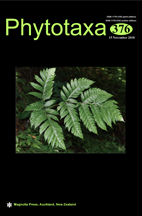Abstract
Chamaesium (Apiaceae) is a morphologically specific genus distributed mainly at high altitudes from East Himalaya to Southwest China. China is an important diversity center of Chamaesium, where most of its species occur. It differs from most Apiaceae taxa by 1- pinnate leaf blade, and fruit with primary and secondary ribs all prominent to narrowly winged. The objective of the present study is to contribute to the phylogenetic relationships within Chamaesium, using the nuclear internal transcribed spacer (ITS) and three plastid makers (rpl16, rps16 and trnT-trnL). Nine species involving 28 populations of Chamaesium, three species of Bupleurum were collected this time and seven sequences of Pleurospermeae clade were obtained from the NCBI, to infer their phylogeny using Maximum parsimony and Bayesian analyses for the first time. The monophyly of Chamaesium is supported, proved that each species belongs to an individual clade, and the differentiation between species is obvious. Some new characteristics such as morphology in fruit and basal leaves, are used in the identification key, and new geographical distribution of Chamaesium species in China were provided. The taxonomic treatments for six species (not include the previously described species) in China including type materials, synonyms, distribution, habitats and specimens examined were carried out comprehensively referring to previous studies and our own fieldwork. A new identification key for the Chinese species of Chamaesium is reported.

